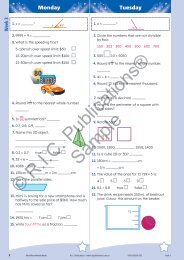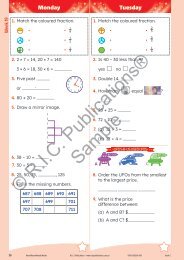RIC-3531 Primary Science - Book D (Digital)
Create successful ePaper yourself
Turn your PDF publications into a flip-book with our unique Google optimized e-Paper software.
Bridge Building<br />
Structures – Activity 3<br />
Lesson Focus<br />
Outcomes<br />
Natural and Processed<br />
Materials<br />
2.11 Observes and describes<br />
the characteristics of<br />
common materials.<br />
Indicators<br />
• Investigates the role of<br />
compression and tension<br />
in deciding whether<br />
structures stay up or fall<br />
down.<br />
• Investigates and applies<br />
previous knowledge to<br />
build a bridge spanning<br />
an open space.<br />
Skills Focus<br />
• Communicates<br />
• Designs and constructs<br />
• Investigates<br />
Background Information<br />
Materials have certain<br />
properties which make them<br />
useful. The materials used<br />
to build bridges need to be<br />
sturdy (strong) and also rigid<br />
(stiff).<br />
There are many different types<br />
of bridges.<br />
Arch bridges can be made<br />
of rows of bricks, stones<br />
or concrete. They get their<br />
strength from the arch itself.<br />
Suspension bridges are<br />
supported by huge cables that<br />
span across the gap.<br />
Other types include girder,<br />
truss and cantilever.<br />
Before the Lesson<br />
Materials Needed<br />
Plastic drinking straws, dressmaking pins, pictures of bridges, rulers.<br />
Preparation<br />
Prepare drinking straws and pins for each group. Each group will need about 50<br />
straws and 50 pins. Organise the class into small groups. Organise desks or areas<br />
to be used.<br />
The Lesson<br />
Stimulus<br />
Show students pictures of a variety of bridges and discuss any bridges in the local<br />
community. Discuss how a simple bridge such as a log over a stream can work<br />
well, but when the distance to be spanned increases, there is a need for special<br />
forces to be controlled by engineering. It is important that students be provided a<br />
‘free-play’ time to get rid of excess excitement related to the materials. Students<br />
could be asked to make as many different shapes as they can.<br />
What to Do<br />
• Explain the task of constructing a bridge over a 40-cm span.<br />
• In this activity students will be required to apply knowledge from previous lessons.<br />
• As in the first activity, ask the class to agree on a set of rules that each group must<br />
abide by when constructing its bridge; for example, ‘The bridge is allowed to be<br />
fixed to the desk using tape’. These rules will ensure that the students are working<br />
to the same guidelines and will bring a feeling of ‘fairness’ to the activity. Display<br />
the rules on the board. The students discuss the rules as a group at the beginning<br />
of the activity.<br />
• Testing the strength of the bridge needs to be discussed; however, suspending<br />
metal washers or similar objects of the same size and weight beneath the bridge is<br />
one useful method.<br />
• Discuss how the bridges will be tested for strength and agree on a common<br />
method.<br />
• The students build their bridges. Allow sufficient time for experimentation to<br />
occur.<br />
• Test the strength of the bridges as a whole class.<br />
• Students complete the activity sheet, identifying the strengths and weaknesses of<br />
their bridge.<br />
After the Lesson<br />
Answers<br />
Answers will vary.<br />
Additional Activities<br />
• Complete the same activity using twice the number of drinking straws. Does this<br />
double the strength of the bridge? Can it be longer?<br />
• Students choose one type of bridge structure (beam, cantilever, arch or suspension<br />
etc.) and find drawings and information about it. The students can draw diagrams<br />
of their bridge and use books and the Internet to find examples from around the<br />
world.<br />
Display Ideas<br />
• Display pictures, photographs and postcards of different types of bridges.<br />
• Display the students’ bridges in a safe area.<br />
• Students could sketch bridges in the local area for display or look at photographs<br />
and pictures of famous bridges and paint them.<br />
©R.I.C. Publications<br />
Low Resolution Images<br />
Display Copy<br />
56 PRIMARY SCIENCE ~ R.I.C. Publications ® ~ www.ricpublications.com.au<br />
ISBN 978-1-925660-54-8


















